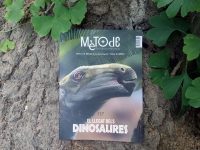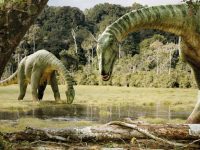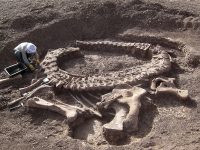The dinosaurs of the Maestrat Basin
Evolution of hadrosauriforms in the eastern Iberian Peninsula
The Maestrat Basin, in the Iberian Range, has proved to be a key point for the study of the hadrosauriform dinosaurs of the Lower Cretaceous in Europe. The Aliaga, Galve, and Morella sub-basins have all yielded abundant fossils of Mesozoic vertebrates, among which dinosaurs, and especially hadrosauriform styracosternan ornithopods, are the most abundant group from these areas. In this article, we review recent findings in the Maestrat Basin, which suggest that the diversity of this clade during the Barremian–Albian interval was greater than originally thought, providing us with valuable information for the study and understanding of the evolution of these dinosaurs.
Keywords: Ornithopoda, Dinosauria, Laurasia, Lower Cretaceous, Iberian Peninsula.
Introduction: The Maestrat Basin
The Maestrat Basin (also known as Maestrazgo in the scientific literature) is a favourable area for the discovery of dinosaur fossils. This basin, which now covers parts of the Spanish provinces of Castellon, Tarragona, and Teruel, has been affected by two major rifting episodes. A rift is a structure that forms a zone of expansion within the continent and is filled with sediments. During the second episode, between the Upper Jurassic and Lower Cretaceous, a system of listric normal faults (faults with a high angle at the surface and an almost horizontal one at depth) divided the basin into seven sub-basins: Oliete, Aliaga, Galve, Penyagolosa, Morella, Salzadella, and Perelló (Figure 1). The sedimentary infill, which occurred at the same time as the second rift (between 156 and 102 million years ago), was more than 4 km thick. In the Maestrat Basin, this sedimentary sequence is characterised by the predominance of shallow-water marine carbonate deposits. When these sediments come from continental or transitional areas, dinosaur fossils are likely to be found there.
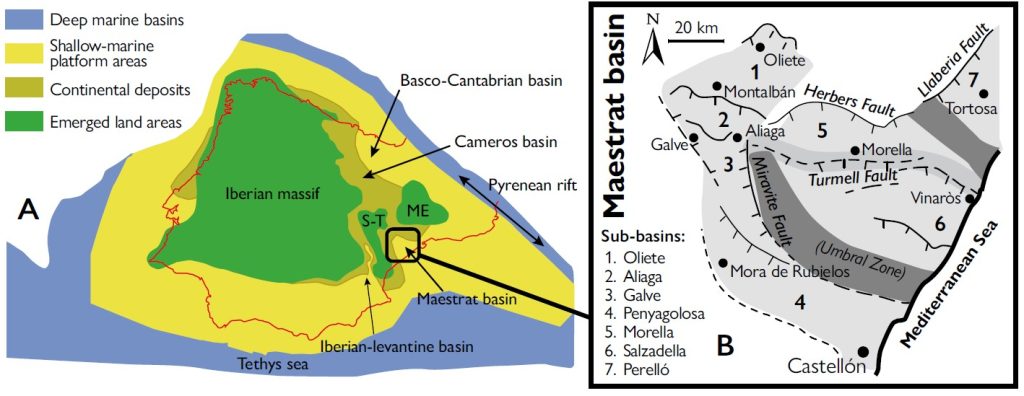
Figure 1. A) Paleogeographic basins of the Iberian plate during the Early Cretaceous epoch, modified from Figure 1 in Santos-Cubedo et al. (2021) under a CC BY 4.0 license. B) Paleogeographic sub-basins within the Maestrat Basin and active faults during Early Cretaceous sedimentation, modified from Figure 1A in Holgado et al. (2019) under a CC BY 4.0 license. The sedimentary infilling that took place during the Second Rift in the Maestrat Basin made it a favourable space for fossil finds.
As a result of this episode, the sub-basins of Aliaga, Penyagolosa, Galve, and Morella have yielded an abundance of Mesozoic vertebrate fossils, among which dinosaurs occupy a prominent place and are the most studied of the vertebrates. Among all non-avian dinosaurs, the hadrosauriform ornithopods are the most abundant group in these sub-basins.
Hadrosauriforms of the Early Cretaceous (Barremian-Albian) in the Iberian Peninsula have historically been represented by the robust Iguanodon bernissartensis and the graceful Mantellisaurus atherfieldensis, similar to other European sites such as those in the English Weald, Belgium, or Germany (Figure 2). In recent years, new species of basal hadrosauriforms have also been discovered and described in the Maestrat Basin. In fact, eight genera and nine species of hadrosauriforms are now known from several European Early Cretaceous formations. Of these nine species, six have been found in the Maestrat Basin and four of them were new to science. These findings suggest that the diversity of this clade of dinosaurs on the Iberian Peninsula during the Early Cretaceous epoch was much greater than had been previously thought.
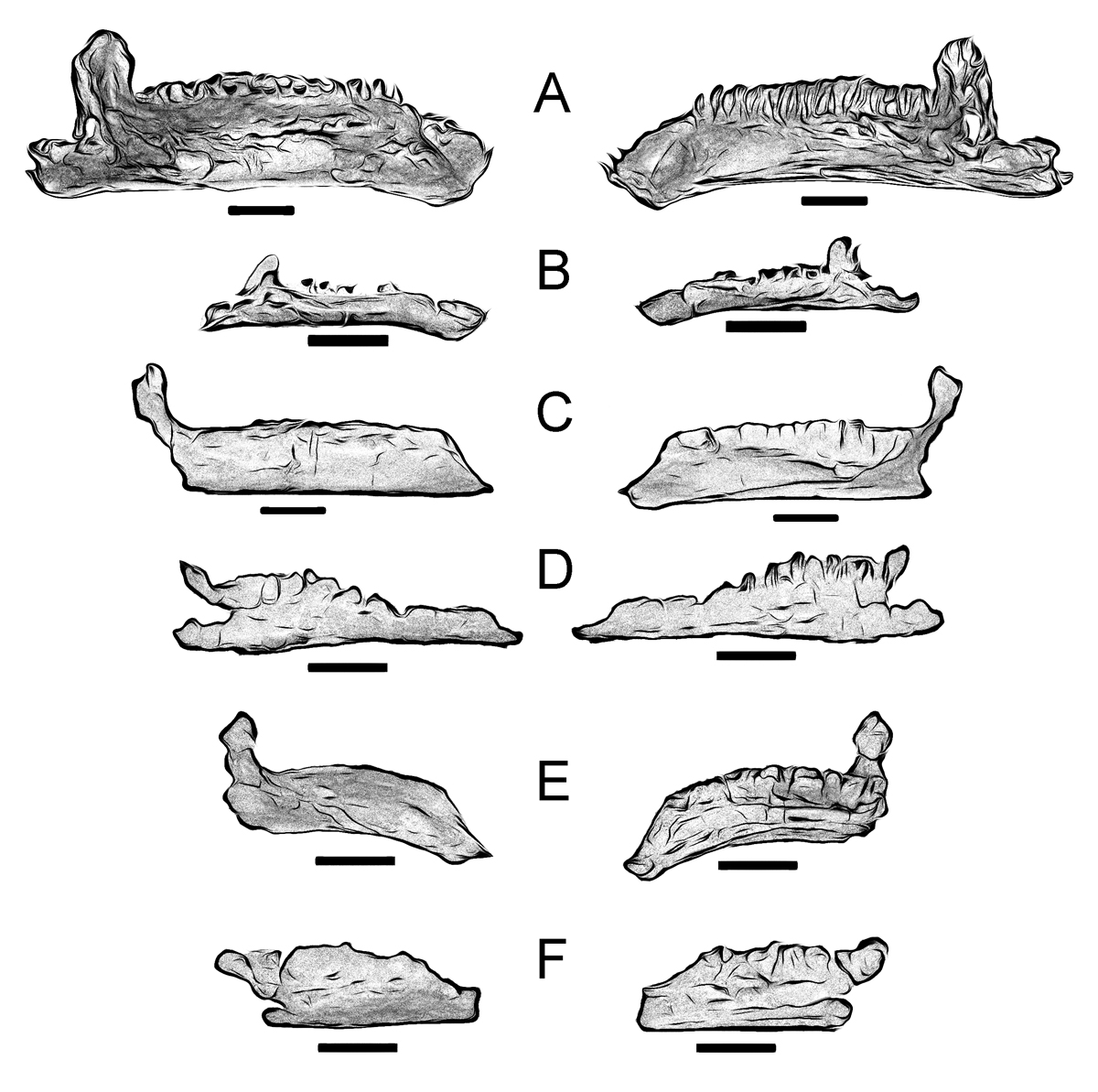
Figure 2. Mandibles (jawbone) of several hadrosauriform ornithopods mentioned in this article (medial and lateral views). The scale bars are 10 cm. A) Iguanodon bernissartensis (IRSNB-1561, horizontally reversed). B) Mantellisaurus atherfieldensis (NHMUK PV R 11521, horizontally reversed). C) Barilium dawsoni (NHMUK PV R 28660). D) Hypselospinus fittoni (NHMUK PV R 1831). E) Proa valdearinnoensis (AR-1-1365). F) Portellsaurus sosbaynati (MQ98-II-1). In the case of vertebrate fossils, the dental and cranial features are very helpful for establishing the morphological characteristics that define each palaeontological species. / Source: modified from Figures 4 and 5 in Santos-Cubedo et al. (2021) under a CC BY 4.0 license.
Learning more about basal hadrosauriforms
Hadrosauriform ornithopods were the most abundant and diverse group of phytophagous (plant-eating) dinosaurs present on the northern hemisphere landmass of Laurasia during the Cretaceous period (Weishampel et al., 2004). Formally, hadrosauriforms are defined as the most inclusive clade, including Hadrosaurus foulkii and the aforementioned Iguanodon bernissartensis. This group also includes all dinosaurs of the Iguanodontidae and Hadrosauroidea clades (Madzia et al., 2021). Indeed, according to these authors, the Iguanodontidae include Barilium dawsoni, Iguanodon bernissartensis, Iguanodon galvensis, and Lurdusaurus arenatus. These were herbivorous dinosaurs of a medium to large size that were usually bipedal or facultatively quadrupedal (quadruped for slow or long distance locomotion), with a conical thumb spike and dental batteries for efficient food grinding.
Historically, several species of styracosternan ornithopods have been described from European sites, mostly related to the genus Iguanodon. However, since 2010, only four taxa of hadrosauriforms have been considered: Barilium dawsoni and Hypselospinus fittoni for the Valanginian stage (140–132 million years ago) and Iguanodon bernissartensis and Mantellisaurus atherfieldensis for the upper Barremian–lower Aptian interval (125–120 million years ago) (Norman, 2013). Although new species have sometimes been proposed, subsequent studies have shown that these were merely synonyms (i.e., the newly described taxon was actually one that already existed) or were nomen dubium (Latin for of ‘doubtful name’, when the type bearing the name is fragmentary, lacks diagnostic characteristics, or the original types have been lost or destroyed), as in the case of Delapparentia turolensis (Norman, 2015). However, in recent years, this scenario has begun to change, and it is in the Iberian Peninsula – particularly in the Maestrat Basin – that scientific studies are contributing to a better understanding of the diversity of this group of dinosaurs.
The classic large hadrosauriforms of the Valanginian are Barilium dawsoni and Hypselospinus fittoni (Figure 2). The holotype of the first of these (i.e., the type specimen) consists of a series of fossils associated with a single partial skeleton collected from a quarry in the village of Shornden, near Hastings (East Sussex, UK). The pieces were found in the Wadhurst Clay Formation and had an approximate age of 138 million years. Barilium dawsoni was a robust dinosaur species measuring about eight metres long and weighing three to four tonnes, with a noticeably short thumb spike in its hand.
The holotype of Hypselospinus fittoni was also found in the Wadhurst Clay Formation in Hastings (East Sussex, UK). This dinosaur – a contemporary of B. dawsoni – was about six metres long, weighed about one tonne, and had large spines.
Iguanodon bernissartensis was described from a complete articulated skeleton (RBINS R51 1534) found in the Sainte-Barbe Clays Formation (upper Barremian–lower Aptian) at Bernissart, Hainaut (Belgium). This large and robust hadrosauriform measured 10 to 13 metres long, weighed about four tonnes, and had a long thumb spike in its hand. Moreover, several skeletons of the same species have also been found.
The holotype of Mantellisaurus atherfieldensis consists of a large skull fragment and a partially articulated skeleton found in Brook Bay in the Isle of Wight (UK), within the Vectis Formation (lower Aptian), and is approximately 121 million years old. With a length of six to seven metres, it weighed about one tonne and was a medium to large dinosaur.
As noted above, both Iguanodon bernissartensis and Mantellisaurus atherfieldensis are well represented in the Weald area of England, but in 2021, a new hadrosauriform, Brighstoneus simmondsi, was described from the Wessex Formation of the Isle of Wight, based on two autapomorphies (unique and distinctive characters of a clade) and a unique combination of characters. It had been a medium to large dinosaur with a prominent nasal protuberance. It measured eight metres long, weighed one tonne (Lockwood et al., 2021), and was approximately 125 million years old (early Barremian).
New discoveries in the Maestrat Basin
In Spain, the mention of hadrosauriforms in some sites dates back to more than 100 years ago. In 1872, Juan Vilanova y Piera, in his Compendio de geología (‘Compendium of geology’), stated that he was in possession of «two large bones» from Utrillas (Teruel), which probably belonged to «Ignanodon [sic] Mantelli». A year later, at the meeting of the Spanish Society of Natural History, he reported this finding, as well as the discovery of another large bone in Morella (Castellon) belonging to Iguanodon (Verdú, 2017). However, subsequent studies of this material seemed to indicate that these first dinosaur fossils found in Spain did not belong to hadrosauriforms but rather, to a theropod in the case of the Utrillas remains and to a sauropod in the case of the Morella fossil (Pereda-Suberbiola & Ruiz-Omeñaca, 2005).
We probably owe the first records of hadrosauriform fossils discovered in Spain to Francisco Beltrán Bigorra who, in 1918, spoke at a meeting of the Royal Spanish Society of Natural History (Valencia section) about the discovery of new Iguanodon remains from the Morella Weald, and to José Royo Gómez who, in 1920, reported the discovery of bones in the area of Morella and Cinctorres, which he attributed to an «Iguanodon sized Mantelli» (Verdú, 2017). After these first records were made, the presence of the genera Iguanodon and Mantellisaurus was also documented in sites in provinces including Burgos, Castellon, Cuenca, and Teruel (Verdú, 2017).
The presence of dinosaurs, including Iguanodon bernissartensis and Mantellisaurus atherfieldensis, has been well documented at sites in the Maestrat basin, for example in the Morella and Galve sub-basins (Santos-Cubedo et al., 2016; Verdú, 2017). However, the finds in the Maestrat basin in the Iberian Range from part of the Cretaceous (lower Barremian to lower Albian) stand out in particular, especially for the presence of four species of hadrosauriforms: Iguanodon galvensis (Verdú et al., 2015), Morelladon beltrani (Gasulla et al., 2015), Portellsaurus sosbaynati (Santos-Cubedo et al., 2021), and Proa valdearinnoensis (McDonald et al., 2012) (Figure 2).
Therefore, the diversity of hadrosauriforms in this basin is higher than in other parts of Europe, with up to six species present within an interval of about 29 million years and at least three different species present in both the lower and upper Barremian stages (Table 1).

Table 1. The diversity of hadrosauriforms in the Maestrat Basin was higher than in other parts of Europe, with up to six species present in an interval of only about 29 million years. The table shows the species of this clade present during the Lower Cretaceous in the Maestrat Basin. Orange marks the hadrosauriform ornithopod species described outside the Maestrat Basin also present in this basin, and green marks the species described in the Maestrat Basin. / Source: created by the author.
Unlike those studying living organisms, vertebrate palaeontologists rarely work with complete specimens, let alone their soft parts. However, some morphological features not repeated in other fossils have helped to establish palaeontological species. In vertebrates, dental and cranial characteristics are extremely helpful in establishing these differences. Thus, we will now examine the main features of the hadrosauriform ornithopods found in the Maestrat Basin.
The holotype of Iguanodon galvensis (MAP-4787) was described in 2015 (Verdú et al., 2015). These fossils were found in the San Cristóbal 1 (SC-1) deposit in a clay mine in the town of Galve (Teruel). The holotype consists of some cranial and postcranial bones of a sub-adult. Nearby, at San Cristóbal 2 (SC-2), more than 1,000 bones belonging to different individuals of the same species were found, including 13 perinates (immature specimens). The fossils were found in the Camarillas Formation in the Galve sub-basin and are approximately 128 million years old. The holotype is a large and robust hadrosauriform (measuring 7 to 9 metres long) which weighed about two tonnes (Figure 3) (Alcalá, 2019).
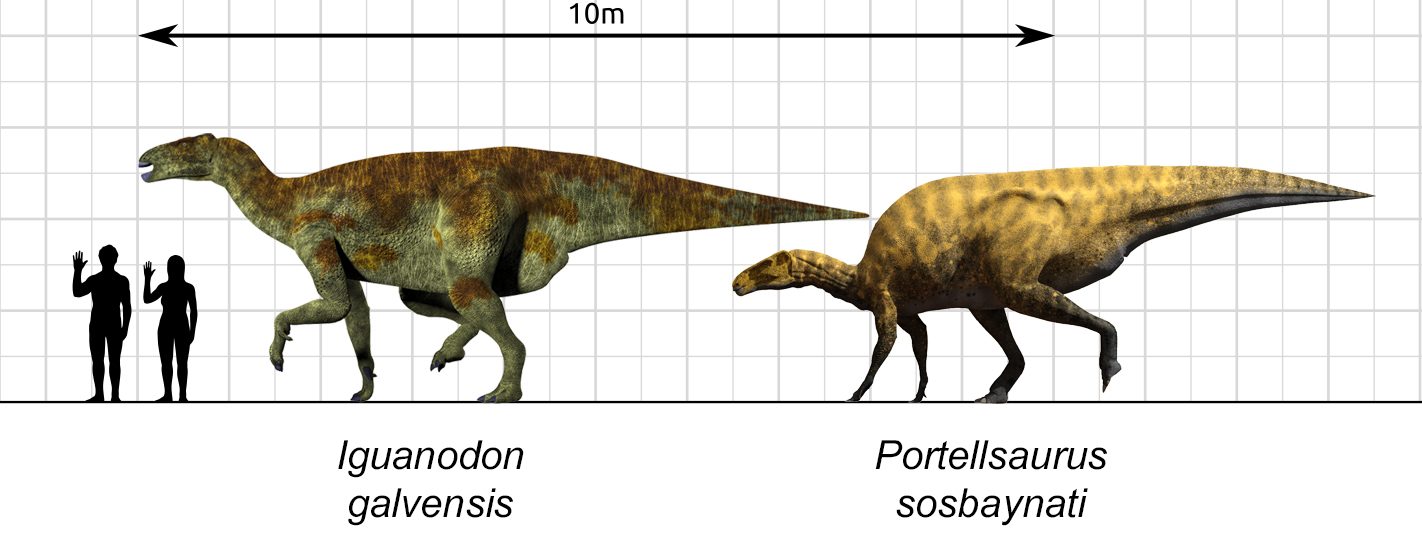
Figure 3. Reconstructions of the hadrosauriforms Iguanodon galvensis and Portellsaurus sosbaynati with reference to their body size (Alcalá, 2019; Meseguer & Santos-Cubedo, 2021).
Following the discovery of this new species, new fossils attributed to it were later found at other sites in the Galve sub-basin, as well as in other sub-basins. In 2021, Verdú and collaborators described the postcranial fossils of an individual they assigned to Iguanodon cf. galvensis, from the Las Dehesillas site (DS-1) in Aliaga (Teruel), found in the Camarillas Formation (lower Barremian) of the Galve sub-basin (Verdú et al., 2021). Only one year later, in 2022, postcranial fossils also attributed to Iguanodon cf. galvensis were described at the CM-8 site in Cabra de Mora (Teruel) in the Penyagolosa sub-basin, located in the El Castellar Formation (upper Hauterivian–basal Barremian), which represents the oldest record of this taxon in the Iberian Peninsula (García-Cobeña et al., 2022).
The holotype of Portellsaurus sosbaynati (MQ98-II-1) was described in 2021 (Santos-Cubedo et al., 2021), based on a right dentary found at the Mas de Curolles II site in the locality of Portell (Castellon). The fossil was found in the Mirambell Formation of the Morella sub-basin (Maestrat Basin) and was dated to the late Barremian, 130–128 million years ago. Portellsaurus sosbaynati would have been 6–8 metres long and would have weighed 1–2 tonnes (Figure 3) (Alcalá, 2019; Meseguer & Santos-Cubedo, 2021). Of note, this is the first dinosaur species described for this geological formation and the oldest species found in the province of Castellon to date.
Morelladon beltrani (holotype CMP-MS-03) was also described in 2015 (Gasulla et al., 2015). The specimen was collected at the Mas de Sabaté site (CMP-MS), within the Mas de la Parreta clay quarry in Morella (Castellon) and consists of a tooth and postcranial bones from one individual. The Arcillas de Morella Formation in the sub-basin of the same name contained these fossils. Morelladon, which had large spines forming a sail on its back (Figure 4) would have been about 6 metres long and would have weighed between 1 and 2 tonnes (Alcalá, 2021; Meseguer & Santos-Cubedo, 2021). The Morella Formation is, approximately, late Barremian in age, making it 127 to 126 million years old.
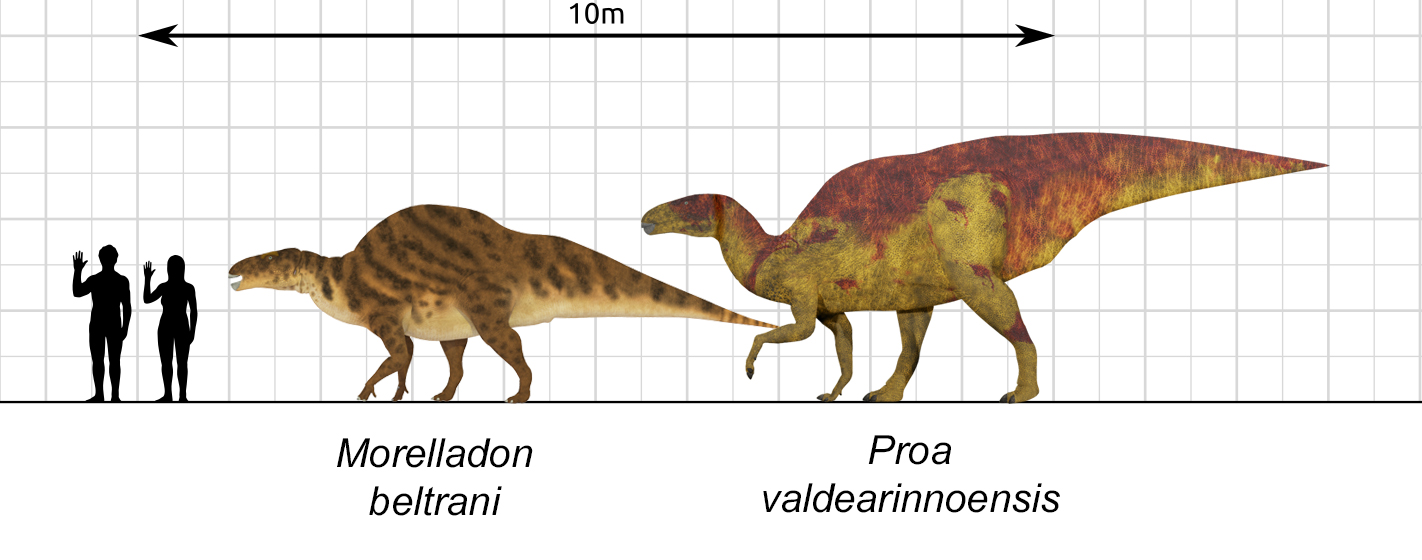
Figure 4. Reconstructions of the hadrosauriforms Morelladon beltrani and Proa valdearinnoensis with reference to their body size (Alcalá, 2019; Meseguer & Santos-Cubedo, 2021).
Proa valdearinnoensis was described in 2012 on the basis of a partial skeleton (AR-1/19), with a partial right surangular (AR-1-2012), a right dentary (AR-1-2013), and an isolated tooth (AR-1-2014) forming parts of the holotype (McDonald et al., 2012). The AR-1 deposit is located in a mining operation, the Santa María mine, in Ariño (Teruel). The fossils were recovered from the lower sedimentary succession of the Escucha Formation in the Oliete sub-basin from the lower Albian and are approximately 113 to 112 million years old. Proa valdearinnoensis would have been between 7 and 8 metres long and would have weighed 1 or 2 tonnes (Figure 4) (Alcalá, 2019; Meseguer & Santos-Cubedo, 2021).Finally, fossils from an undetermined hadrosauriform iguanodontid, which could be a new species, have recently been described from the Barranco del Hocino-1 site (Estercuel, Teruel) in the upper part of the Blesa Formation in the Oliete sub-basin (Medrano-Aguado et al., 2023).
Extending the record of Iguanodon galvensis
Iguanodon galvensis is defined on the basis of a unique combination of characters present in adult specimens of the species that are not present in Iguanodon bernissartensis. In addition, it is defined based on an additional unique combination of characters present in perinates or juveniles of Iguanodon galvensis that may be susceptible to ontogenetic variation, but which are not present in adult specimens of Iguanodon bernissartensis. In the latter case, the combination of characters in immature Iguanodon galvensis present a unique combination of cranial (quadrate) and mandibular (dentary) characters.
In 1982, Santafé and collaborators published a monograph on the dinosaurs of the Capas Rojas de Morella (Castellón), in which they described several fossils from the sites of El Beltrán (Teuleria Azuvi), Mas Romeu, Mas Macià Querol, the Escuelas Pías Collection, Masía Eroles, and Mas de Guimera, that determined that the bones belonged to Iguanodon bernissartensis. Among the fossils described there, the piece M-MQ 79-1, a left dentary shown as Plate 3, stands out (Santafé et al., 1982, p. 106). In the words of these authors, «in occlusal view, the anterior part of the dentary is convex, and the posterior part is concave». This character was described by Verdú et al. (2018) and Verdú et al. (2021) as an autapomorphy (a derived character found in only one taxon) of Iguanodon galvensis («dentary with the dorsal margin close to the symphyseal region with a short, abrupt, and marked convexity») which is not present in adult specimens of Iguanodon bernissartensis. On this basis, the fossils recovered from the Mas Macià Querol site (M-MQ 79-1 to M-MQ 79-9) and described in Santafé et al. (1982) have been tentatively reassigned to that of Iguanodon galvensis (Figure 5). This implies, on the one hand, an extension of the geographical distribution of this hadrosauriform species to the Morella sub-basin, and, on the other hand, represents the most modern dating of the species to date (the upper Barremian stage, 127–126 million years ago).
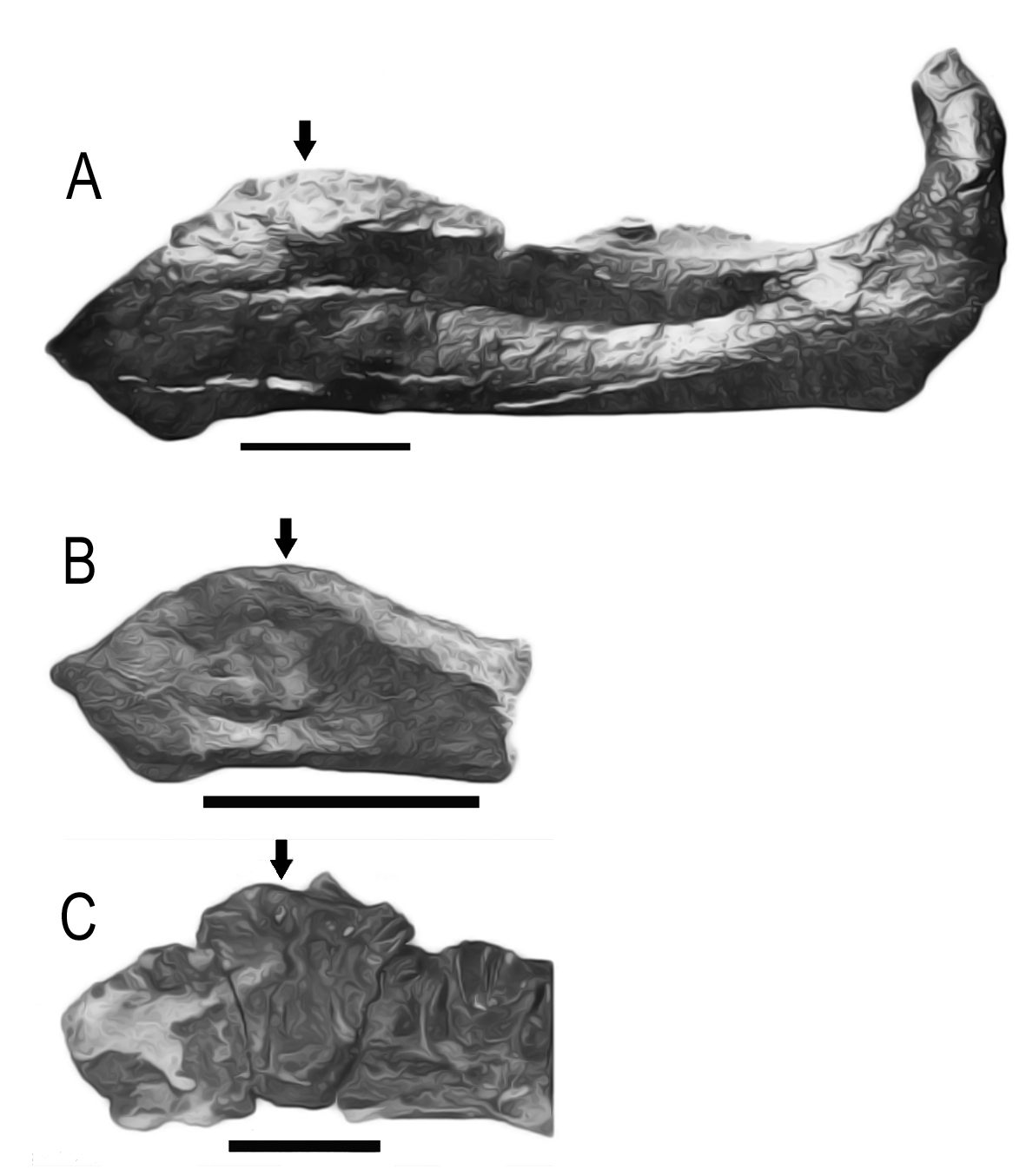
Figure 5. A) Left dentary (M-MQ 79-1), buccal view (redrawn from Santafé et al., 1982). B) Right juvenile dentary (SCH-10 [paratype]), medial view (redrawn from Sanz et al., 1984. Acta Geológica Hispánica, 19). C) Detail of the rostral end of the perinatal right dentary (MAP-5152) in a medial view (redrawn from Verdú et al., 2015). Arrows indicate the autapomorphy of Iguanodon galvensis, i.e., the characteristics found only in this taxon: dentary with the dorsal margin close to the symphyseal region with a short, abrupt, and pronounced convexity (Verdú et al., 2018; Verdú et al., 2021). Scale: 10 cm (A), 5 cm (B), and 1 cm (C).
Conclusions: Maestrat, a key scenario
The Maestrat Basin is proving to be key for studying the evolution of the basal hadrosauriform ornithopods of the Lower Cretaceous in Europe. The fossil record from Belgium and the United Kingdom has provided extensive information on the anatomy and palaeobiology of these dinosaurs. In the case of the Iberian Peninsula in general, and the Maestrat Basin in particular, the fossil record also provides information on the generic and specific diversity of the group.
Thus, Iguanodon galvensis (the upper Hauterivian–lower Barremian interval, and perhaps the upper Barremian) is present in the Galve, Morella, and Penyagolosa sub-basins; Iguanodon bernissartensis (Barremian) and Mantellisaurus atherfieldensis (upper Barremian) are in the Galve and Morella sub-basins; Portellsaurus sosbaynati (lower Barremian) is in the Morella sub-basin; Morelladon beltrani (upper Barremian) is also in the Morella sub-basin, and Proa valdearinnoensis (lower Albian) is in the Oliete sub-basin. Hence, based on the study of the hadrosauriforms of the Maestrat Basin during the Barremian–Albian interval, it is clear that the diversity and abundance of dinosaurs from this clade present in the Iberian Peninsula is greater than that of other parts of southwestern Europe during the Lower Cretaceous series, making it an important paleogeographic scenario for the study of the evolutionary history of the group.
As some authors have already suggested, the longevity and expected diversity of dinosaur species may be complex and subject to bias. Indeed, the average longevity of the species could even be as low as 200,000 years (Schopf, 1984; Lockwood et al., 2021). Therefore, the high diversity of Iberian ornithopods compared to the rest of the European continent, where only two species groups (Barilium–Hypselospinus and Iguanodon–Mantellisaurus) were found for long periods of time, challenges both the Iberian and the European evolutionary models. The former would be characterised by high generic and specific diversity over a short period, with the latter comprising only four long-lived genera. Therefore, the study of the hadrosauriforms of the Maestrat Basin helps to test both these hypotheses.
Institution abbreviations
The following abbreviations have been used throughout this article: RBINS (Royal Belgian Institute of Natural Sciences, Brussels, Belgium); AR (Santa María de Ariño Mina, Ariño, Teruel, Spain); NHMUK (Natural History Museum of the United Kingdom, London, United Kingdom); MAP (Museo Aragonés de Paleontología, Teruel, Spain); SC (San Cristóbal Mina, Galve, Teruel, Spain); Las Dehesillas (Aliaga, Teruel, Spain); CM (Cabra de Mora, Teruel, Spain); CMP-MS (Mas de la Parreta-Mas de Sabater Cantera, Morella, Castellon, Spain); MQ-II (Mas de Curolles II, Portell, Castellon, Spain); M-MQ (Mas Macià Querol, Morella, Castellon, Spain); and SCH (San Cristóbal Mina, Galve, Teruel, Spain).
Acknowledgements
The author would like to thank Dr. Luis Alcalá for his invitation to participate in this monograph, as well as the editors, Dr. Xabier Pereda Suberbiola, and an anonymous reviewer for their comments that helped to improve the manuscript.
References
Alcalá, L. (2019). Dinosaurios de la península ibérica. Susaeta Ediciones.
García-Cobeña, J., Verdú, F. J., & Cobos, A. (2022). Abundance of large ornithopod dinosaurs in the El Castellar Formation (Hauterivian-Barremian, Lower Cretaceous) of the Peñagolosa sub-basin (Teruel, Spain). Journal of Iberian Geology, 48, 107–127. https://doi.org/10.1007/s41513-021-00185-w
Gasulla, J. M., Escaso, F., Narváez, I., Ortega, F., & Sanz, J. L. (2015). A new sail-backed styracosternan (Dinosauria: Ornithopoda) from the Early Cretaceous of Morella, Spain. PLOS ONE, 10, e0144167. https://doi.org/10.1371/journal.pone.0144167
Holgado, B., Pêgas, R. V., Canudo, J. I., Fortuny, J., Rodrigues, T., Company, J., & Kellner, A. W. A. (2019). On a new crested pterodactyloid from the Early Cretaceous of the Iberian Peninsula and the radiation of the clade Anhangueria. Scientific Reports, 9(4940). https://doi.org/10.1038/s41598-019-41280-4
Lockwood, J. A. F., Martill, D. M., & Maidment, S. C. R. (2021). A new hadrosauriform dinosaur from the Wessex Formation, Wealden Group (Early Cretaceous), of the Isle of Wight, southern England. Journal of Systematic Palaeontology, 19(12), 847–888. https://doi.org/10.1080/14772019.2021.1978005
Madzia, D., Arbour, V. M., Boyd, C. A., Farke, A. A., Cruzado-Caballero, P., & Evans, D. C. (2021). The phylogenetic nomenclature of ornithischian dinosaurs. PeerJ, 9, e12362. https://doi.org/10.7717/peerj.12362
McDonald, A. T., Espílez, E., Mampel, L., Kirkland, J. I., & Alcalá, L. (2012). An unusual new basal iguanodont (Dinosauria: Ornithopoda) from the Lower Cretaceous of Teruel, Spain. Zootaxa, 3595, 61–76. https://doi.org/10.11646/zootaxa.3595.1.3
Medrano-Aguado, F., Parrilla-Bel, J., Gasca, J. M., Alonso, A., & Canudo, J. I. (2023). Ornithopod diversity in the Lower Cretaceous of Spain: New styracosternan remains from the Barremian of the Maestrazgo Basin (Teruel province, Spain). Cretaceous Research, 144, 105458. https://doi.org/10.1016/j.cretres.2022.105458
Meseguer, S., & Santos-Cubedo, A. (2021). Nuestros dinosaurios. Enseñanza de las Ciencias de la Tierra, 29(1), 5–17.
Norman, D. B. (2013). On the taxonomy and diversity of Wealden iguanodontian dinosaurs (Ornithischia: Ornithopoda). Revue de Paléobiologie, 32, 385–404.
Norman, D. B. (2015). On the histology, osteology, and systematic position of the Wealden (Hastings group) dinosaur Hypselospinus fittoni (Iguanodontia: Styracosterna). Zoological Journal of the Linnean Society, 173(1), 92–189. https://doi.org/10.1111/zoj.12193
Pereda-Suberbiola, X., & Ruiz-Omeñaca, J. I. (2005). Los primeros descubrimientos de dinosaurios en España. Revista Española de Paleontología, 20(3), 15–28. https://doi.org/10.7203/sjp.20.3.20576
Santafé, J. V., Casanovas, M. L., Sanz, J. L., & Calzada, S. (1982). Geología y Paleontología (Dinosaurios) de las Capas rojas de Morella (Castellón, España). Diputación Provincial de Castellón & Diputación de Barcelona.
Santos-Cubedo, A., García-Robles, J., Poza, B., de Santisteban, C., & Meseguer, S. (2016). Vertebrados mesozoicos en la provincia de Castellón. Loisele Ediciones.
Santos-Cubedo, A., de Santisteban, C., Poza, B., & Meseguer, S. (2021). A new styracosternan hadrosauroid (Dinosauria: Ornithischia) from the Early Cretaceous of Portell, Spain. PLOS ONE, 16(7), e0253599. https://doi.org/10.1371/journal.pone.0253599
Schopf, T. J. M. (1984). Rates of evolution and the notion of “living fossils”. Annual Review of Earth and Planetary Sciences, 12, 245–292. https://doi.org/10.1146/annurev.ea.12.050184.001333
Verdú, F. J. (2017). Sistemática, filogenia y paleobiología de Iguanodon galvensis (Ornithopoda, Dinosauria) del Barremiense inferior (Cretácico Inferior) de Teruel (España). [PhD thesis], Universitat de València.
Verdú, F. J., Royo-Torres, R., Cobos, A., & Alcalá, L. (2015). Perinates of a new species of Iguanodon (Ornithischia: Ornithopoda) from the lower Barremian of Galve (Teruel, Spain). Cretaceous Research, 56, 250–264. https://doi.org/10.1016/j.cretres.2015.05.010
Verdú, F. J., Royo-Torres, R., Cobos, A., & Alcalá, L. (2018). New systematic and phylogenetic data about the early Barremian Iguanodon galvensis (Ornithopoda: Iguanodontoidea) from Spain. Historical Biology, 30, 437–474. https://doi.org/10.1080/08912963.2017.1287179
Verdú, F. J., Royo-Torres, R., Cobos, A., & Alcalá, L. (2021). Systematics and paleobiology of a new articulated axial specimen referred to Iguanodon cf. galvensis (Ornithopoda, Iguanodontoidea). Journal of Vertebrate Paleontology, 40, e1878202. https://doi.org/10.1080/02724634.2021.1878202
Weishampel, D. B., Barrett, P. M., Coria, R. A., Le Loeuff, J., Xu, X., Zhao, X. J., Sahni, A., Gomani, E. M. P., & Noto, C. R. (2004). Dinosaur distribution. En D. B. Weishampel, P. Dodson, & H. Osmólska (Eds.), The Dinosauria (Second Edition) (p. 517–606). University of California Press.


